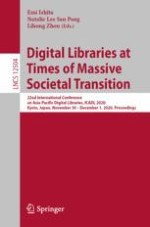2020 | Book
Digital Libraries at Times of Massive Societal Transition
22nd International Conference on Asia-Pacific Digital Libraries, ICADL 2020, Kyoto, Japan, November 30 – December 1, 2020, Proceedings
Editors: Assoc. Prof. Emi Ishita, Natalie Lee San Pang, Prof. Lihong Zhou
Publisher: Springer International Publishing
Book Series : Lecture Notes in Computer Science
